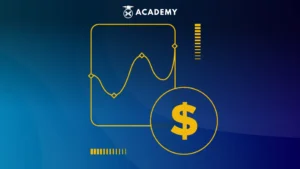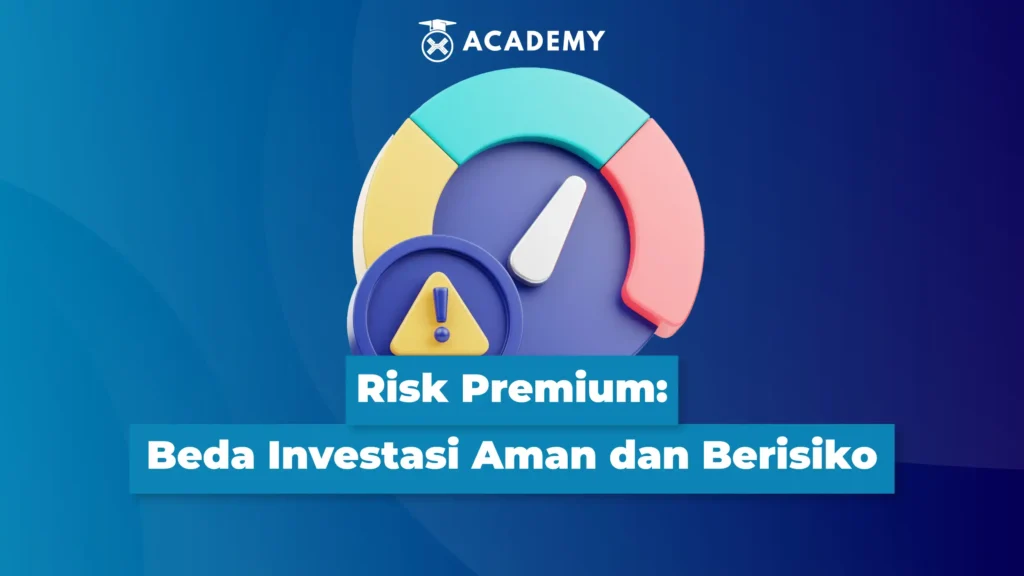In investing, the principle is simple: the greater the potential profit, the greater the risk. In other words, climbing a mountain offers a more beautiful view, but it’s also more challenging than climbing a hill.
For example, stocks can provide high returns, but they fluctuate sharply. Conversely, government bonds are more stable, but their returns are relatively small.
From this comparison, the concept of risk premium emerged, which is the difference in returns that compensates for the additional risk. This is a tool for assessing whether a risk is worth the reward.
What is a Risk Premium?

When someone chooses to invest their money in risky assets like stocks or cryptocurrencies, there’s one important consideration: is the risk worth the potential return?
This is where the concept of risk premium comes into play. Simply put, risk premium is the difference in returns between a risky investment and a risk-free investment, such as government bonds.
Because government bonds or gold have a very low probability of failure, it’s natural that the returns offered are relatively low.
Conversely, instruments like stocks, cryptocurrencies, or blockchain-based projects offer the potential for much greater returns, but also come with the potential for significant losses.
To make the additional risk worthwhile, investors will demand an additional return. This is called a risk premium, a kind of “extra money” for daring to face uncertainty.
Without higher compensation, few people would be willing to invest their money in assets with the potential for high fluctuations.
The function of the risk premium is also important. Besides serving as a form of compensation, it also helps investors evaluate the soundness of an investment choice.
By calculating and comparing risk premiums, investors can make more rational and proportionate decisions, maintaining a balance between potential returns and the level of risk they are willing to take.
In short, risk premium is a mental and financial measure that demonstrates that every investment decision is not just about profit, but also about courage and careful calculation.
Real-Life Examples of Risk Premiums in the Investment World
Imagine you’re considering two investment options. The first is a government bond with a 5% annual yield, which is relatively safe and almost guaranteed to be paid on time.
The second is a technology company stock that promises a 12% annual return, but of course carries a higher risk because its value can fluctuate and even result in a loss.
In this case, the difference in yield between the two, 12% minus 5%, is 7%. That’s what’s called the risk premium.
This 7% figure reflects the compensation investors expect for choosing an asset that has the potential to fail or lose value.
Of course, investors aren’t immediately tempted just because the figure is higher. They’ll ask themselves: “What are the chances I’ll actually receive that 12%?”
If the company has a questionable track record or the industry is unstable, any risk premium may be deemed unjustified.
The same principle applies when investors are faced with a choice, such as investing in a blockchain project offering a 12% return versus a tech company stock yielding 7%, or a government bond yielding 5%.
In this scenario, the risk premium for bonds is 7%, and for stocks it is 5%.
However, if the blockchain project repeatedly fails to pay returns to previous investors, the seemingly attractive 12% figure could be a sham.
This is where the risk premium becomes crucial. It’s not just a figure of the yield difference, but also a tool for assessing whether the additional risk is worth taking.
Careful investors don’t just chase high numbers, but also consider the realistic likelihood of actually achieving those returns.
Types of Risk Premiums You Should Know
In the investment world, risk premiums are divided into several types, depending on the source of risk and the characteristics of the assets involved.
Understanding each type will help you understand the logic behind high returns and the potential losses that accompany them. Here are some important types to know, including:
1. Equity Risk Premium
This type refers to the additional return investors expect when purchasing stocks compared to risk-free investments like government bonds.
Stocks often provide dividends and the potential for price appreciation, but they are still subject to volatile market fluctuations.
In conventional markets, this concept is used to assess whether the returns from stocks are worth the market risks they face.
In the crypto world, a similar approach applies. Investors who invest in digital assets like tokens or coins expect significantly higher returns due to the high price volatility and the lack of guaranteed dividends or asset protection.
2. Credit Risk Premium
This risk premium arises when investors lend to parties whose financial condition is not entirely stable, such as companies with low credit ratings or developing countries with a risk of default.
In practice, investors demand higher returns to compensate for the uncertainty of repayment. This is also relevant in the crypto ecosystem.
For example, when investors lend crypto assets to an underdeveloped or less transparent DeFi platform, they will expect significantly higher interest rates to cover the risk that the platform will fail to repay.
3. Market Risk Premium
This refers to the difference in returns between the average return of the overall market, such as a stock index, and a risk-free asset.
This concept is widely used in calculating expected returns through models such as the CAPM, which helps investors assess whether investments in the market in general provide returns commensurate with their risks.
In the crypto market, a similar principle applies. Investors often compare the performance of the overall crypto market (for example, using total market cap or a digital asset index) with the potential returns and volatility they face.
4. Country Risk Premium
This risk premium arises when investors invest in countries with unstable political, legal, or economic conditions.
Uncertainty related to inflation, policy changes, or currency devaluation leads investors to expect higher returns.
In real-world contexts, global investors take this risk into account when entering emerging markets. In the crypto world, the effects of country risk are also felt.
In some countries with extreme inflation or unstable financial policies, people tend to turn to digital assets like Bitcoin as an alternative store of value.
However, because regulations can change at any time and security is not always guaranteed, investors still demand higher risk compensation before entering these markets.
Factors Influencing the Risk Premium
The risk premium is not fixed, as it can rise or fall depending on market conditions and external factors that influence risk perception.
The following are some of the main factors that play a role in determining the risk premium, including:
1.Interest Rates
When interest rates rise, risk-free assets such as government bonds become more attractive because they offer higher returns without much risk.
As a result, investors will demand a higher risk premium from risky assets to remain competitive. Conversely, when interest rates fall, the risk premium tends to narrow.
2.Global Economic Conditions
In unstable economic situations, such as high inflation, slowing growth, or recession, the risk premium typically increases.
Investors seek higher returns because the risk of company bankruptcy, declining purchasing power, or market volatility is higher. Conversely, during times of economic stability and growth, the risk premium decreases because the potential for business failure is lower.
3.Investor Perception of Risk
Market sentiment significantly influences the risk premium. When investors tend to be fearful or pessimistic (for example, during a financial crisis or geopolitical tension), they will demand higher returns before being willing to take risks.
However, if the market is optimistic and confident, investors tend to be more tolerant of risk, resulting in a lower risk premium.
4.Monetary Policy and Geopolitics
Central bank decisions such as raising or lowering interest rates, as well as geopolitical tensions such as war or trade conflicts, can increase market uncertainty.
This makes investors more cautious and demands a higher risk premium. When policy is stable and the global situation is under control, the risk premium can also decrease because the overall risk is perceived as lower.
Risk-Free Asset vs. Risky Asset: What’s the Difference?

In the world of investing, understanding the difference between risk-free assets and risky assets is crucial for weighing returns more rationally.
Risk-free assets, such as government bonds from economically and politically stable countries, are considered almost certain to provide timely returns.
The risk of default is so small that these instruments are often used as a reference or benchmark for measuring the performance of other assets.
The return on a risk-free asset reflects the lower limit of the returns an investor can obtain without facing market uncertainty.
Conversely, risky assets such as stocks have the potential for greater returns, but also carry price fluctuations and a much higher risk of loss.
Stock values ??can fall drastically due to various factors, ranging from company performance to global economic conditions.
Therefore, investors who choose risky assets demand additional returns, and this is where the risk premium plays a crucial role.
The risk premium is the additional return investors expect when choosing a risky asset over a perceived safe asset like government bonds. This concept forms the basis for rational investment decisions.
By comparing the risks and returns of various instruments, investors can determine whether the returns offered are commensurate with the level of uncertainty they face.
Without understanding these differences and carefully calculating the risk premium, investment decisions can become mere speculation, rather than a well-thought-out, analytically based strategy.
Why is the Risk Premium Important for Investors?
In the investment world, the risk premium is more than just a technical term; it is a crucial tool that helps investors rationally weigh risk and potential returns.
By knowing the risk premium of an asset, investors can assess whether the offered returns are truly worth pursuing, or whether they are too risky to accept.
As a measuring tool, the risk premium helps answer a key question: “Is the risk I’m taking worth the promised return?”
If the answer is no, then the investment decision should be reconsidered. Without this calculation, investors can easily be tempted by high returns without realizing the potential for significant losses.
For novice investors, understanding the risk premium helps them be wiser and avoid simply following trends. Meanwhile, retail investors can use it to build a balanced portfolio of safe and risky assets.
In fact, even institutional investors rely heavily on this concept to make large-scale decisions because, at the corporate level, a single error in risk analysis can have billions in impact.
Essentially, the risk premium is the foundation of rational and calculated investment decisions. Without understanding it, investing turns into speculation.
Conclusion: Don’t Just Look at Returns, Also Consider the Risk Premium
So, that was an interesting discussion about the Risk Premium, which you can read in full at the INDODAX Academy Crypto Academy.
In conclusion, when investing, high returns are inherently tempting.
However, don’t be dazzled by the promise of large returns, as behind every opportunity, there’s always an accompanying risk. This is where understanding the risk premium becomes crucial.
The risk premium isn’t designed to scare investors, but rather to help them calculate whether an investment is worth taking based on the balance between risk and potential return.
It’s a very useful tool for distinguishing emotional decisions from logical, measured ones.
Remember, investing isn’t about recklessness, but about calculation. By understanding the risk premium, you can choose instruments that align with your risk tolerance and financial goals, rather than simply chasing high returns without careful consideration.
By the way, in addition to broadening your investment horizons, you can also stay updated with the latest crypto news and directly monitor digital asset price movements on the INDODAX Market. Don’t forget to activate notifications to stay up-to-date with the latest information about digital assets and blockchain technology, only on INDODAX Academy.
You can also follow our latest news through Google News for faster and more reliable access to information. For an easy and secure trading experience, download the best crypto app from INDODAX on the App Store or Google Play Store.
Maximize your crypto assets with the INDODAX Earn, feature, a practical way to earn passive income from your holdings.
Follow us on social media here: Instagram, X, Youtube & Telegram
DISCLAIMER: All forms of crypto asset transactions carry risks and the potential for loss. Always invest based on independent research to minimize the risk of loss of your crypto assets (Do Your Own Research/ DYOR). The information contained in this publication is provided in a general, non-obligatory manner and is for informational purposes only. This publication is not intended to be, and should not be construed as, an offer, recommendation, solicitation or advice to buy or sell any investment product and should not be transmitted, disclosed, copied or relied upon by any person for any purpose.




 Polkadot 8.92%
Polkadot 8.92%
 BNB 0.50%
BNB 0.50%
 Solana 4.81%
Solana 4.81%
 Ethereum 2.37%
Ethereum 2.37%
 Cardano 1.35%
Cardano 1.35%
 Polygon Ecosystem Token 2.13%
Polygon Ecosystem Token 2.13%
 Tron 2.85%
Tron 2.85%
 Market
Market


